Are you tired of your recipes failing to come through perfectly like they do in the recipe tutorials? Chances are, you aren’t following the recipe right. Following recipes exactly as stated may sound cliché, but experts say you need to do so in order to get them just right.
This is especially important with different types of vegetable cuts, since recipes mention cooking times according to the cuts stated. In turn, these cuts determine the overall flavour, aroma, and presentation of your dish.
It is important to get the hang of this knife skill so that you render perfectly delectable dishes every time.
There are many types of vegetable cuts that you will come across in your culinary endeavours. These include basic strip cuts such as julienne, baton, batonette and chiffonade, dice cuts such as brunoise and macedoine, and other special cuts such as paysanne, lozenge and mirepoix.
Let’s look at these vegetable cuts in greater detail:
Table of contents
Common vegetable cuts
Julienne

Also known as the allumette or the matchstick cut, this French knife technique vegetable cut renders thin, long strips of food similar to matchsticks.
Size
The julienne cut is usually about 4 cm in length, or 3mm x 3mm x 5cm in dimensions.
Ideal uses
The julienne cut ensures that everything cooks at a uniform rate while maintaining the crunchiness of veggies. This cut is usually incorporated in salads, green veggies, stir fry’s, and garnishes. Practically used on any type of vegetable, it is popularly used to cut veggies such as carrots, cucumbers, capsicum, celery, and zucchini.
Simple how-to
- To make a julienne cut, simply square off the desired vegetable.
- Proceed to cut lengthwise in slices of 3mm each.
- Next, cut these slices into matchsticks.
Voila! Your juliennes are ready.
Baton
The baton is basically a larger and thicker version of the julienne cut.
Size
Being the largest vegetable stick cut, it is usually about 8mm or 1/2×1/2×2-1/2 inches in dimensions.
Ideal uses
The baton cut is largely used in dressings and salads. Thick cut steak fries also usually sport the baton veggie cut. Moreover, this cut works well for almost all the vegetables including carrots, zucchini, and cucumber.
Simple how-to
- If you want to cut your vegetables into batons, simply slice your vegetables into the desired length.
- Next, trim all the sides and cut into sticks of 1/2×1/2×2-1/2 inches each.
Voila, your baton cut vegetables are ready.
Batonnet
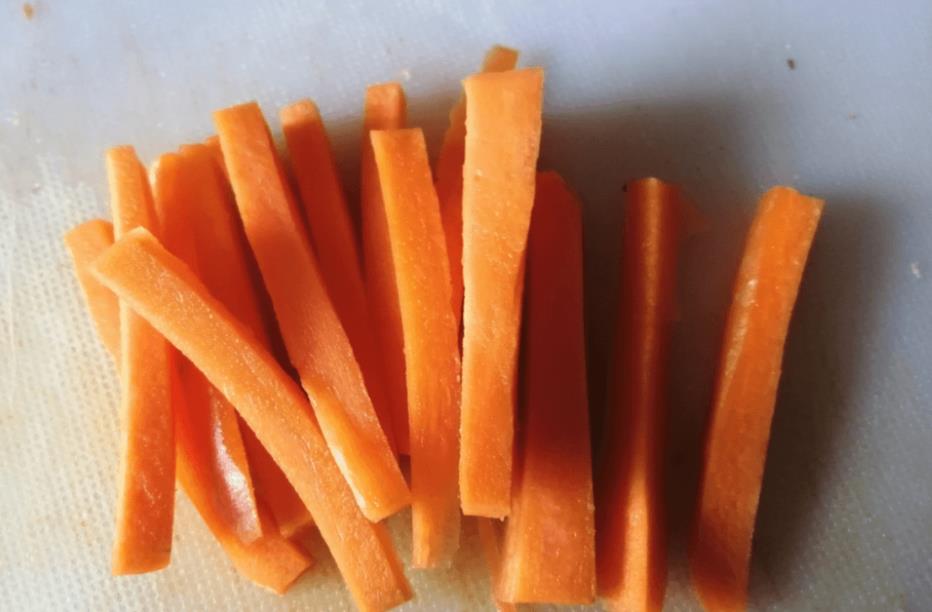
The batonnet cut is the base cut for all dice, julienne and even the brunoise cut. This matchstick-like cut falls somewhere in between the julienne and the baton cut.
Size
The batonnet cut measures 1⁄4 by 1⁄4 by 2–2+1⁄2 inches in dimensions.
Ideal uses
Recipes call for batonnet cuts when they require rapid and easy cooking or are served to be eaten raw. This type of vegetable cut is used in french-fries, vegetable sticks and crudites.
Simple how-to
- For achieving this type of vegetable cut, begin by squaring off your vegetable.
- Next, cut them lengthwise into rectangular slices of 6mm thickness.
- Lastly, cut them into sticks of 6mm thickness each.
Chiffonade
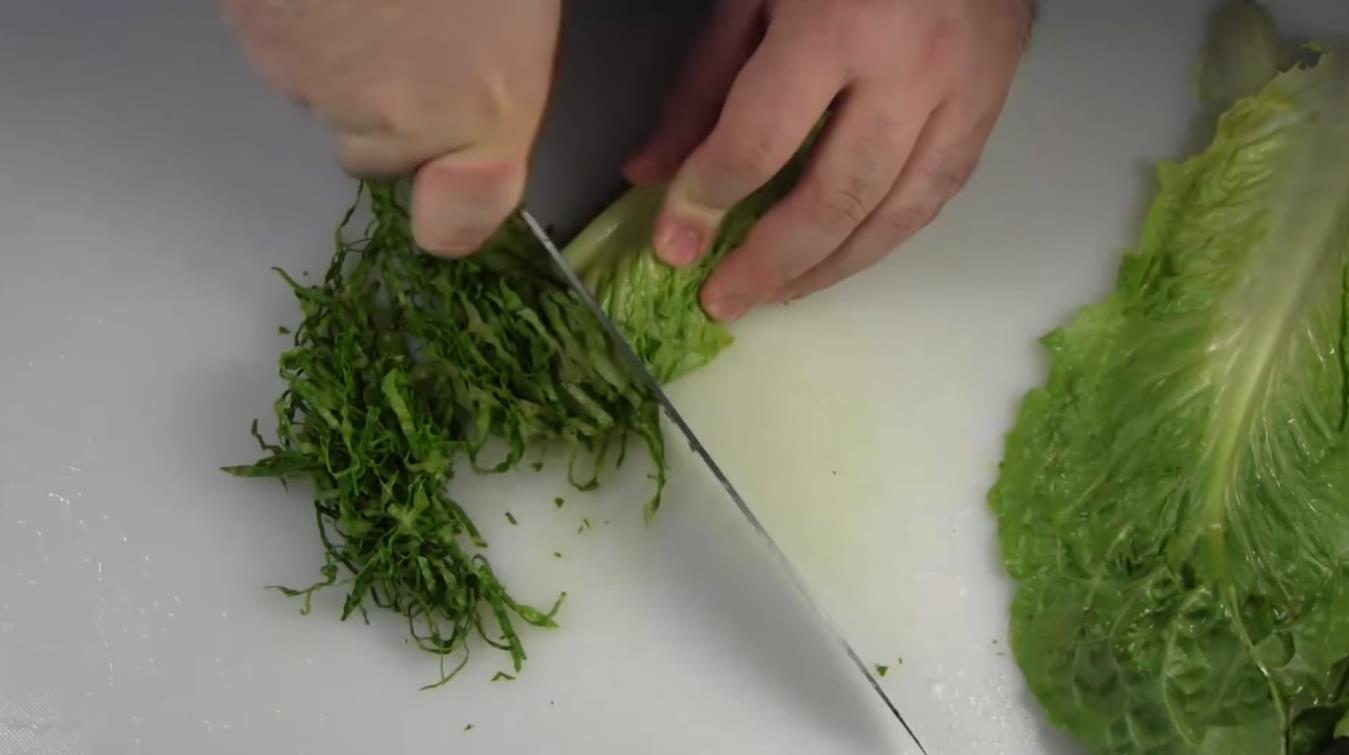
Another common vegetable cut is the chiffonade. The word chiffonade is French for “little ribbons”. Soft herbs and leafy green vegetables are sliced into a chiffonade cut, or thin strips similar to little ribbons.
Size
The chiffonade cut ranges from 4-10mm in width.
Ideal uses
The chiffonade cut is largely used for stuffing, garnishing (fine chiffonade) as well as sauté (large chiffonade). Leafy greens such as lettuce, spinach, and herbs such as basil and mint are common vegetables for sporting this type of a cut.
Simple how-to
- For accomplishing the chiffonade, simply stack your greens or herbs together.
- Next, roll them up and slice them perpendicularly.
Your chiffonade is ready. Learn more about chiffonade cuts here.
Brunoise
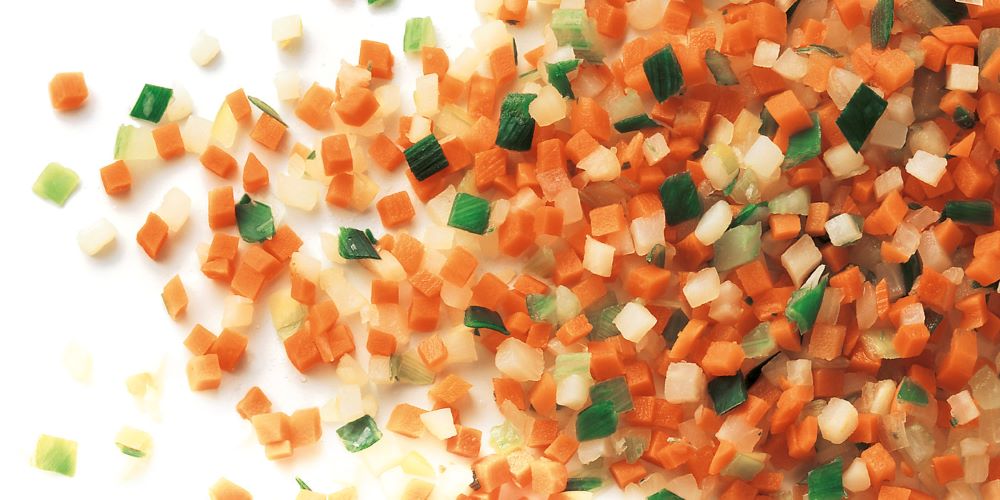
This knife cut allows you to create small diced cubes, and is the second tiniest cut after the mince cut.
Size
The Brunoise cut usually ranges between 1-3mm square each side. The cubes are of uniform and precise measurements, with a regular brunoise side measuring 3mm or 1/8 inch and a fine brunoise cut measuring 2mm or 1/16 inch.
Ideal uses
The brunoise cut is usually used in garnishes, stuffing and making sauces such as tomato concasse. The cut is ideal when you wish to add flavor to your dish without altering its aesthetics. Commonly used vegetables for this cut are turnips, onions, carrots and celery.
Simple how-to
- For achieving the Brunoise cut, cut your vegetable in juliennes
- Next, cut the juliennes into uniform cubes of 3mm thickness.
Macedoine or small dice
The next dice after the brunoise is the small dice or macedoine which are cube shaped dice. The Macedoine, is a French cooking term which refers to a mixture of veggies.
Size
The macedoin cut measures around 5-6mm or ¼ inches each.
Ideal uses
The cut is largely used as a garnish for salsas and Consommes, in salads, sauté’s and even soups. Ideal vegetables for this type of cut are root vegetables such as carrots, turnips, etc.
Simple how-to
- You can achieve small dice cuts by simply julienne cutting your veggies
- Next, proceed to cut through them crosswise, ¼ inches each.
Parmentier or medium dice
The next common vegetable cut that you are going to come across in various recipes is the medium dice cut or the parmentier. Similar to small dice, the only difference is that of size.
Size
These cubes are almost double the size of small dices, bearing dimensions of 1/2*1/2*1/2 or 13mm.
Ideal uses
This type of a cut is largely used in salads and sauté preparation for aesthetics and even cooking. Common vegetables used for medium dicing include tomatoes, potatoes, etc.
Simple how-to
- Prepare your vegetables by peeling and cutting off ends.
- Trim the sides to produce a flat surface and place on a cutting board.
- Cut in slices of ½ inches, turn and slice in the same measurement again.
- From the top, slice ½ inch cubes as well.
Carre or large dice
Carre or large dice is the largest dice cut of all.
Size
The large dice is a vegetable cut that sports six even sides measuring 2cm or ¾ inches each.
Ideal uses
This type of a dice cut is ideal for use in stews and other dishes with longer cook times such as broths and soups.
Simple how-to
- For achieving the carre vegetable cut, cut your vegetable into planks
- Proceed to cut them into ¾ inch sticks.
- Next, simply line them together and cut cubes of ¾ inches each.
Other vegetable cuts
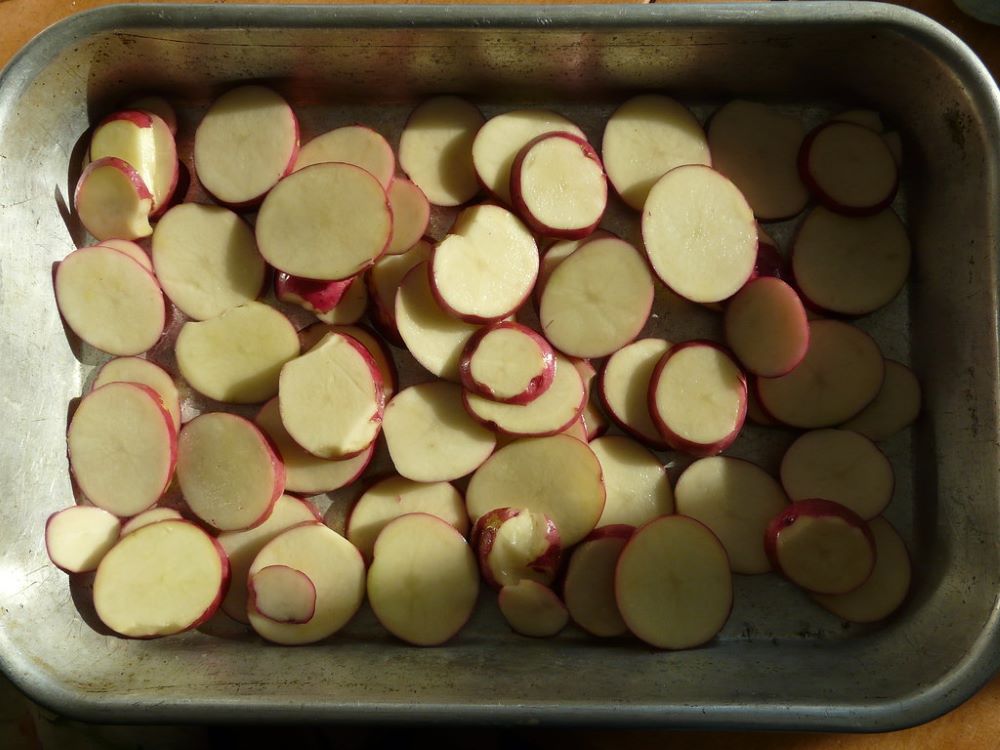
Slicing
Another common vegetable cut largely used across recipes is slices. This type of cutting technique renders cutting broad and thin slices of food.
Ideal uses
The sliced version of vegetables is used on a variety of food items, such as potatoes. It is commonly used in salads, grills, baked items and other similar delicacies.
Simple how-to
- For cutting your veggie into slices, simply cut across your vegetable into uniform, thin slices.
Mincing

Lastly, mincing is another common vegetable cut that you must have come across during your culinary endeavours. This cut entails finely cut vegetables into uniform pieces that are even smaller than diced and chopped versions.
Ideal uses
The mince cut is perfect for aromatics, such as mincing ginger and garlic, or onions when a paste-like texture is demanded in a recipe. It is also used in stuffing and garnishes.
Simple how-to
- Peel the vegetables and cut off root and stem.
- Make very fine slices.
- Next, cut them crosswise.
- Rock your knife over the veggies to produce even smaller bits.
Vegetable Cuts Chart
| Vegetable Cut | Dimensions | Used in | Common Veggies |
| Julienne | 1⁄8 by 1⁄8 by 1–2 inches | Salads, green veggies, stir fry’s, garnishes | carrots, cucumbers, capsicum, celery, zucchini |
| Baton | 1⁄3 by 1⁄3 by 2+1⁄2–3 inches | Dressings, salads, steak fries | Potatoes and potentially all other vegetables |
| Batonette | 1⁄4 by 1⁄4 by 2–2+1⁄2 inches | French-fries, vegetable sticks and crudites | Carrots, potatoes, cucumbers, etc. |
| Chiffonade | 4-10mm | Stuffing, garnishing, sauté | Leafy greens, herbs |
| Brunoise | 1⁄8 inch (3 mm) | Garnishes, stuffing, sauces | Turnips, onions, carrots and celery |
| Small dice | 1⁄4 inch (5 mm) | Salads, sauté’s, even soups | Root vegetables |
| Medium dice | 1⁄2 inch (13 mm) | Salads, sauté preparation | Potatoes, tomatoes etc. |
| Large dice | 3⁄4 inch (20 mm) | Broths, soup | Almost all veggies |
Handpicked for you
True cutting power in the palm of your hand
Special cuts
Paysanne
The paysanne is a special type of chop vegetable cut in which the shape of the vegetable itself decides which cut it will incorporate, such as a triangle, circle, half round or even square. For instance, carrots are cut into thin circles while potatoes are cut into cubes.
The cut consists of slices that are about 1mm in thickness. Moreover, the cut is largely incorporated in soups and trims during aromatic preparations.
For cutting your vegetable into paysanne cut, begin by cutting the veggie such as carrot lengthwise. Next, cut in quarters and proceed to cut into thin slices of 1mm thickness each.
Lozenge

The lozenge cut is basically a diamond shaped vegetable cut. It is largely used for decorative purposes in cooking. The cut is 1⁄2 * 1⁄2 * 1⁄8 inch (10 mm × 10 mm × 3 mm) in dimensions.
For achieving the lozenge cut, chop your vegetable into a batonnet first. Next, rotate your batonnet to a 45 degree angle and proceed to slice them.
Mirepoix
The mirepoix is a diced vegetable cut incorporating carrots, celery and onions. This aromatic flavour base consists of veggies that are about 5-7mm in thickness.
Japanese cutting techniques and culinary traditions
Now that you are well aware of the different types of vegetable cuts, let us learn how to further improve upon the texture, flavour, as well as overall look of our culinary endeavours. This is possible by employing various Japanese cutting techniques.
The Japanese have certain cutting techniques for describing their precise cutting styles. Employing these cuts allows dishes not only to look great but also taste better. Their timeless traditions are a reflection of their aesthetically pleasing cuisines and exquisite taste.
Here are a few Japanese cutting techniques you should know:
Hangetsugiri or half-moon cut

This vegetable cut allows cutting cylindrical or spherical veggies into half rounds or half circles such that they resemble a half-moon. They are largely used for stir fried and boiled dishes, as well as soups and stews. Commonly used vegetables are radish, carrots, and tomatoes.
Sengiri or thousand cut
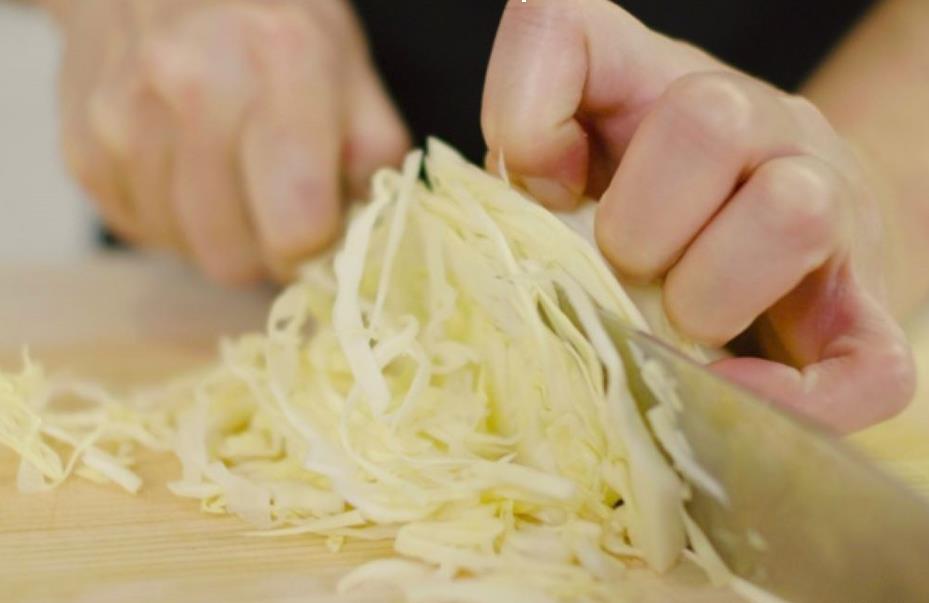
The Thousand cut is when you cut your vegetables into long thin strips similar to julienne, with dimensions of 6-7 cm x 1-2 mm. Cabbage, carrots, and gingers are cut in this cutting style.
Kazarikiri or decorative cut
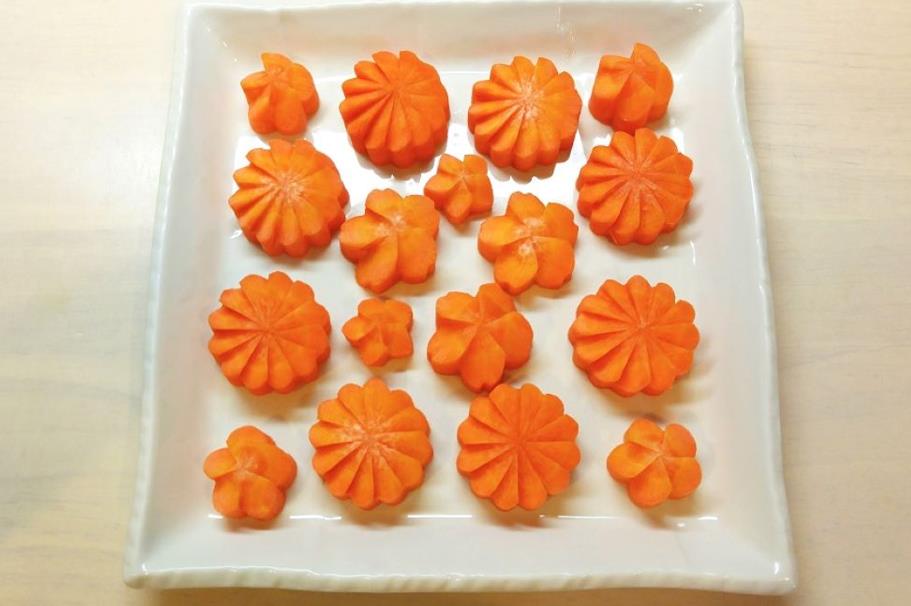
This is a decorative vegetable cut that allows you to create flower shapes and other decorative figures on your vegetables. Used for decoration and accent, the vegetables that are usually used include carrots, lotus roots and mushrooms.
Rangiri or random shape cut
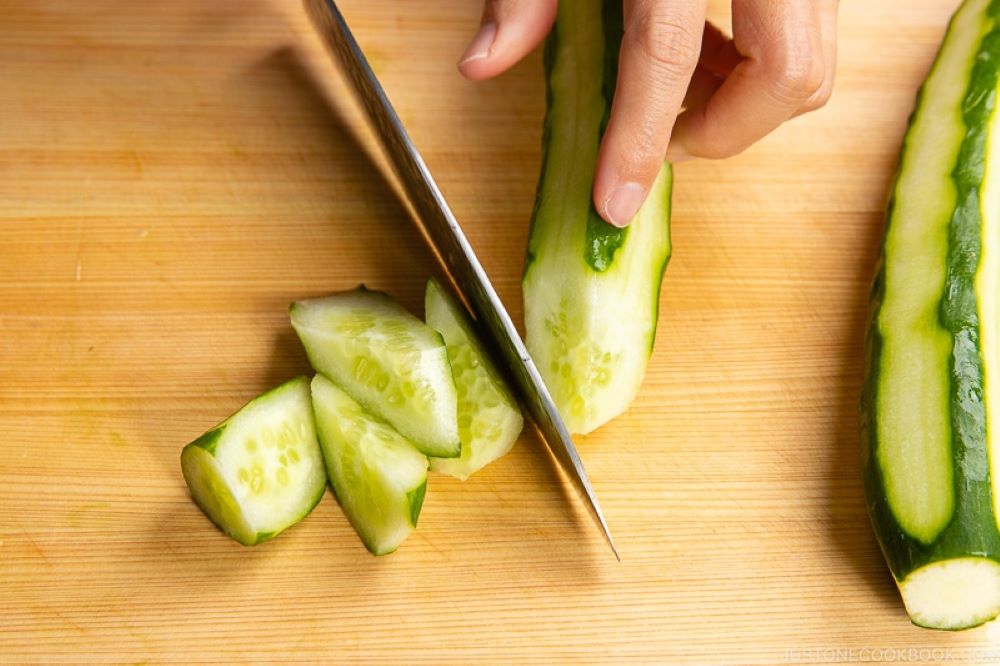
The rangiri cut allows cutting random shapes, with uniform sizes. Cylindrical vegetables are usually cut in this manner, including carrots, cucumbers, and lotus roots. This type of cut creates large, even surfaces that are best for simmering since they allow absorption of flavour.
Sasagaki or bamboo leaf cut
The sasagaki cut allows cutting vegetables by shaving them similar to sharpening a pencil. Carrots and gobos are used for this cut.
There are many other Japanese cutting techniques as well, such as Sogigiri or angle slicing cut which allows slicing vegetables at a 45 degree angle, Tanzakugiri or strip of paper cut, which includes rectangular cutting your vegetables and further cutting into thin strip like cuts, etc.
In conclusion
Now that you have mastered the different types of vegetable cuts, it’s time to put your knife skills to test. Before moving on to test your knife skills, however, make sure you have a sharp knife to begin with.












